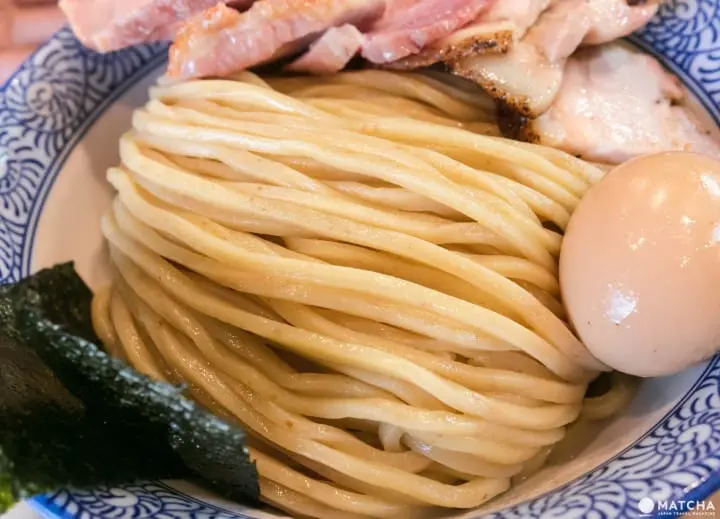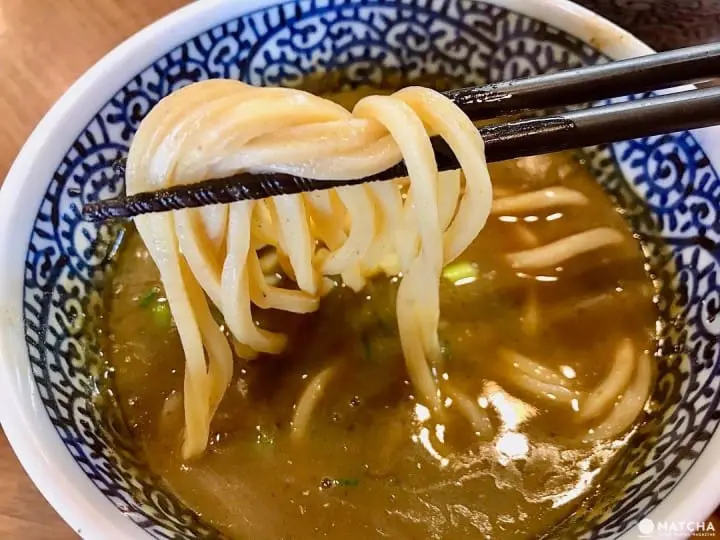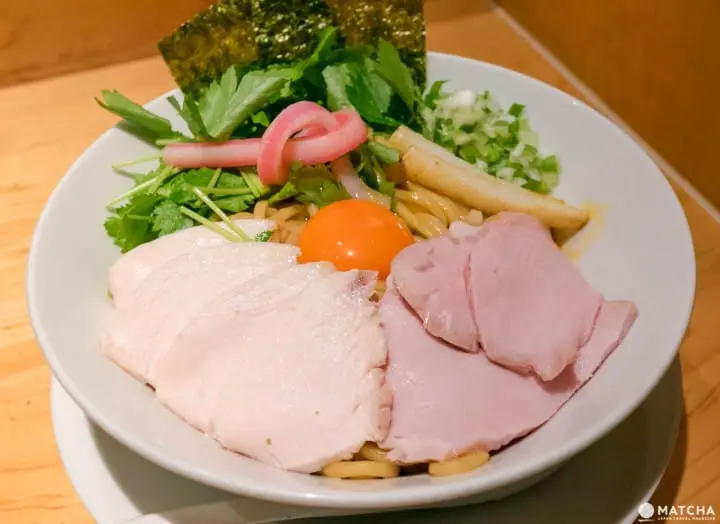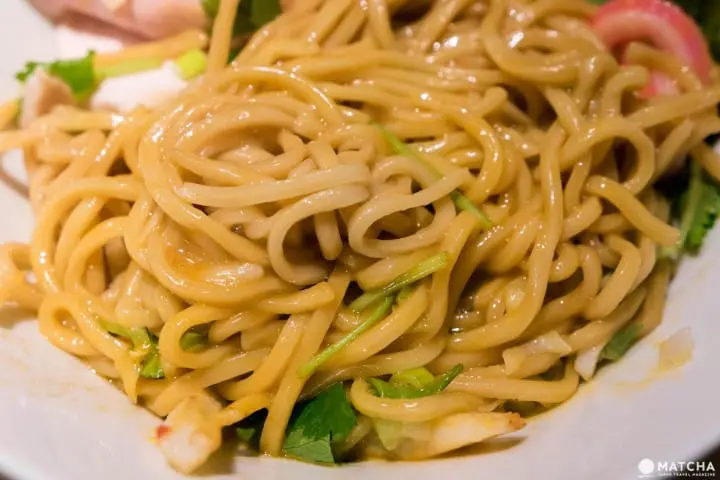Tsukemen and Abura Soba Noodles: Differences and How to Eat Them

Tsukemen, dipping noodles, and abura soba, or soup-less oil noodles, are two ramen noodle dishes popular in Japan. Learn how to eat these dishes and how to tell the difference between them, as explained by a ramen expert.
1. The Difference Between Ramen and Tsukemen
Tsukemen dishes can be widely seen in many ramen shops. The friends of MATCHA's ramen expert frequently ask various questions about these dipping noodles:
- Why are the soup and noodles separate?
- Why are the noodles cold when the soup is hot?
- What is soup wari?
Many people, even those living in Japan, do not know the answers to these questions. International visitors may have even more questions about this dish. This article focuses on the differences between ramen and tsukemen and how to eat tsukemen, as explained by a ramen expert.
1.1 What Is Tsukemen?

Like shown in the picture above, tsukemen is a dish where the soup and noodles are served in separate bowls. Standard Japanese tsukemen come with a rich soup made with tonkotsu (pork bone broth) and chicken, and thick noodles.
While ramen contains cooked noodles in a bowl of piping hot soup, tsukemen noodles are boiled and chilled, then placed in a separate bowl from the soup. The cooling process of the noodles is the main difference between tsukemen and ramen.
1.2 Taste the Noodles First

So, why do the noodles need to be chilled? This is in order to bring out the noodle flavor. By adding this step, any excess slickness of the noodles is washed off. Not only does this improve the texture but it also adds a strong firmness to the noodles.
In order to enjoy the flavor of the noodles, eat the noodles on their own first. If you visit a popular restaurant, you may be surprised at the strong flavor of the noodles and are how tasty they are on their own.
Depending on the restaurant, there are places that will provide salt especially for the noodles.
1.3 Quickly Dip the Noodles in the Soup and Eat!

After enjoying the noodles on their own, dip the noodles in the soup and eat.
The great part about tsukemen is that, unlike ramen, you control how much of the noodles you want to dip into the soup. You don't have to soak all the noodles. If you want to enjoy the flavor of the noodles more, simply dip the noodles into the broth about halfway.
Depending on the tsukemen you will want to change how much noodle you dip, but if the soup is the standard, rich soup, the writer recommends around halfway or three-fourths into the soup. Try different tsukemen and find your favorite.
However, the one thing you shouldn't do is leave the noodles dipped in the soup. Doing this makes the soup get cold quickly, which does not taste good. Very few restaurants have a soup that tastes good even when it's chilled.
Therefore, it is suggested you pick up just enough noodles to eat in one bite, dip them quickly, and savor the flavors. This way of eating is crucial to enjoying tsukemen.
There's also something called the atsumori style where you eat hot noodles in hot soup, but we don't recommend this eating method either. This prevents the soup from getting cold, but you lose the true flavor of the noodles mentioned earlier.
1.4 Finish with Soup Wari to Enjoy Until the Last Drop

After eating a good bowl of tsukemen, the best and last part is the soup-wari where you add hot dashi-broth to the soup to make it drinkable. It is said that this method comes from the soba-yu (hot water used to boil the soba noodles) served after eating soba noodles (there are various theories about this).
Since the noodles are so critical in tsukemen, there are many places that serve a bold and rich flavored soup to balance the noodles out. Therefore, it is not suited for drinking straight. The soup-wari makes the rich soup drinkable with a lighter broth.
This shop has the dashi broth in a pot that can be used for soup wari. However, most shops require you to ask the people in the store for the broth. If you are unsure, ask the staff "soup wari kudasai" (may I have some soup wari).
Many of the stores are also very particular about their soup wari and the broth contain a mix of seafood, chicken or other ingredients. You can normally receive soup wari free of charge, so if you are able to eat more at the end of the meal, try asking for some.
You will notice a change in flavor when mixing in the soup wari, allowing you to enjoy the soup until the last drop. There are some shops that make a different dashi broth for the soup wari daily. It makes you wonder if it's okay to consume this for free.
So far, we have explained the differences between ramen and tsukemen and how to eat them. However, there are some exceptions to this, as restaurant menus are different and people enjoy variations on these dishes. We highly recommend you to go to several ramen shops to find your favorite way of enjoying tsukemen.
2. The Difference Between Ramen and Abura Soba
Next up is the abura soba, a dish that can be found in many ramen restaurants in Tokyo. The writer has often heard the following questions:
- What is the difference between abura soba and ramen?
- Since it has the word abura (oil) in its name, does that mean it's bad for your body?
Like the tsukemen, we will answer questions regarding abura soba and how to eat it.
2.1 What is Abura Soba?

Abura soba is soupless ramen. Generally, ramen is made with a soy sauce, salt or a base sauce of some sort, combined with pork or seafood broth, then drizzled with a flavored oil, to make the soup. However, abura soba doesn't have dashi broth, and contains only a small amount of the sauce and oil.
Noodles are placed in a bowl with sauce and oil. Like ramen, they are topped with char siu (barbecue pork) and green onions. Occasionally, there are some ramen shops that mix the noodles with the sauce and oil before adding the topping.
2.2 How to Eat Abura Soba

The standard way of eating these soup-less oil noodles is to mix the dish very well, as shown in the picture above. The sauce tends to sink to the bottom of the bowl so you should mix it thoroughly to achieve an even flavor.
The restaurant employees will likely also tell you to mix it together. However, if it is already pre-mixed, you won't have to.

Another recommendation for abura soba is to try the different seasonings to change the flavor. Since the abura soba doesn't have any soup, it a simple dish you can enjoy the noodles and the sauce.
Seasonings include rayu (spicy chili oil), vinegar, garlic, and other selections, depending on the restaurant. Any seasonings on the counter are free of charge, but there are some shops that offer toppings that require an additional fare.
2.3 Is Abura Soba Actually Healthy?
From the name, many may assume that abura soba (oil noodles) is high in calories or that is bad for your health. Despite this, abura soba is actually said to be healthier than ramen.
We cannot recommend it to people who are on a serious diet, but since it does not contain any soup, abura soba is lower in sodium and calories than ramen. Please note that the differences only come from the lack of soup. If you don't drink the soup from your ramen, the calorie and sodium count will be around the same.
3. Get Your Fill of Tsukemen and Abura Soba in Japan
This article explained the differences between ramen, tsukemen, and abura soba, and how to enjoy eating them. Use this article as a guide when indulging in delicious tsukemen and abura soba in Japan. You will surely find one of your preference.
Read also
旅と音楽とラーメンをこよなく愛するエンジニア。 中学生のときにオーストラリアでホームステイしたことをきっかけに、学生時代はバックパッカーにハマる。そんな中で改めて日本の良さを実感し、それをもっと世界中に広めたいと思ってMATCHAのライターに。 マイブームはカメラで、最近はHDRとタイムラプスに挑戦中。













































![[2026] Top 5 Strawberry Picking Spots in Tokushima, Naruto| Farms and Access Guide for January to May](https://resources.matcha-jp.com/resize/720x2000/2025/03/06-227165.webp)
![[Yamanashi/ Hokuto City] 4 Hot New Spots Opening in 2026](https://resources.matcha-jp.com/resize/720x2000/2025/12/12-252747.webp)


